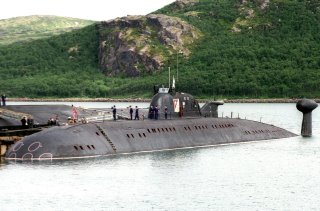Russia Can't Forget These Tragic Submarine Accidents
Fires onboard submarines are not like a fire inside a house. Submarines are non-combustible by design—even the paint inside subs is nonflammable.
Here’s What You Need to Remember: The Losharik also has a few features that lend credence to the idea that it is a spy sub.
Russian submarines flirt with disaster. The Kursk suffered a fire in 2000 and sank, killing 118 sailors. In 2008, 20 sailors died of asphyxiation on the Nerpa when an automatic fire extinguishing system was accidentally activated. The Ekaterinburg caught fire in 2011 with nuclear weapons onboard. The Losharik too had an accident onboard, with multiple fatalities.
Losharik
The Losharik was laid down in the late 1980s just before the collapse of the Soviet Union. Due to financial constraints in Russia following the collapse, the Losharik was not commissioned until 2003. The submarine is reportedly operated by Russian military intelligence, the GRU, rather than the Russian Navy though Navy personnel are presumed to make up the crew.
The Losharik’s design is quite unique. Inside the streamlined outer hull are seven titanium spheres. The rear two spheres house the sub’s nuclear reactor and propulsion unit, while the forward five spheres provide space for crew and equipment. The submarine is presumably quite cramped, but these spheres allow the submarine to dive thousands of feet below the surface, to depths that would crush most other submarines—supposedly over 8,000 feet, or about 2,400 meters.
The Losharik also has a few features that lend credence to the idea that it is a spy sub. It has four retractable skids that would allow the sub to sit on the ocean floor, protecting the propeller and control surfaces from damage, and at least one extendable robotic arm that can manipulate objects outside the submarine. The Losharik had previously taken ocean floor rock samples to bolster Russia’s claim to wide swaths of the Arctic region.
It also can be docked to a larger “mothership” submarine, a modified Delta IV-class with a hitch underneath that the Losharik can clip into for transport.
Aside from grainy satellite photos, not much photographic evidence of the Losharik was available. In 2014, the Russian version of Top Gear, an automotive program, published photos of an ocean-side SUV test that captured the Losharik in the background. The Losharik was likely going to or coming from the Severodvinsk shipyard.
Fire
Though propelled by a nuclear reactor, the Losharik also has onboard batteries that can store extra electric power. The fire on the Losharik likely started in one or multiple battery compartments, for reasons that are not entirely clear.
Fires onboard submarines are not like a fire inside a house. Submarines are non-combustible by design—even the paint inside subs is nonflammable. Rather than an open flame, a fire would likely be noticed by smoke or smoldering. Due to the especially cramped conditions on the Losharik, battling the blaze was likely made even more difficult.
Kommersant, a Russian business newspaper, speculated that the fire may have been caused by replacement batteries that were lithium-ion, rather than the original silver-zink batteries, which could have caused a short circuit or explosion.
14 sailors died as a result of the fire. Four of them were awarded Russia’s highest honor, Hero of the Russian Federation. A Russian naval aid reinforced the idea of the deceased sailors as heroes, saying that, “with their lives, they saved the lives of their colleagues, saved the vessel and prevented a planetary catastrophe,” in a possibly hyperbolic gesture.
Information Warfare
To understand why the Losharik can dive so deeply, one has to consider what lies on the ocean floor at such astounding depths—underseas fiber-optic cables.
An estimate by a UK-based think tank estimated that every day, underseas cables conduct “97% of global communications and $10 trillion in daily financial transactions.” A disruption in information transmission could be a crippling economic (or military) blow—and Russian submarines are already on patrol or operating in some capacity near these cables.
Sailing On
The Losharik will likely be repaired and put back to sea- assuming the damage was not catastrophic- though Russian naval repairs are notoriously slow. While the Losharik will be out of commission for some time, the possibility of Russian tampering with undersea cables is not over. Undersea fiber-optic cables remain exposed and unprotected.
Caleb Larson holds a Master of Public Policy degree from the Willy Brandt School of Public Policy. He lives in Berlin and writes on U.S. and Russian foreign and defense policy, German politics, and culture.
This article first appeared in 2020 and is being reprinted due to reader interest.
Image: Reuters

